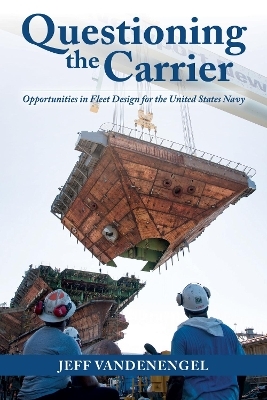
Questioning the Carrier
Opportunities in Fleet Design for the U.S. Navy
Seiten
2023
Naval Institute Press (Verlag)
978-1-68247-870-7 (ISBN)
Naval Institute Press (Verlag)
978-1-68247-870-7 (ISBN)
Examines how the US Navy can embrace the Age of the Missile, network the distributed fleet, and diversify to develop a fleet that benefits from the aircraft carrier’s many strengths without being wholly dependent on them.
The nuclear-powered aircraft carrier is naval history’s most powerful and versatile warship. It is the reason the U.S. Navy is the predominant force at sea today. Throughout its illustrious history, the carrier has overcome serious flaws, including its expense, vulnerability, centralization of combat power, and its airwing’s short range. The U.S. Navy always accepted those flaws because the carrier was the best means of delivering firepower. Today’s technologies, however, provide key opportunities for the U.S. Navy to move beyond the limitations of a carrier-centric fleet by redesigning its force structure.
Questioning the Carrier examines how the U.S. Navy can embrace the Age of the Missile, network the distributed fleet, and diversify to develop a fleet that benefits from the aircraft carrier’s many strengths without being wholly dependent on them. By acting on those opportunities, the U.S. Navy can develop a structure that performs the carrier-centric fleet’s functions more effectively using a force consisting of more platforms with less total risk and within the same long-term budget. As adversaries are improving their ability to deter the carrier thus causing its utility to wane, the author examines the Navy’s past successes to show how it can overcome institutional resistance to change and continue to rule the seas.
The nuclear-powered aircraft carrier is naval history’s most powerful and versatile warship. It is the reason the U.S. Navy is the predominant force at sea today. Throughout its illustrious history, the carrier has overcome serious flaws, including its expense, vulnerability, centralization of combat power, and its airwing’s short range. The U.S. Navy always accepted those flaws because the carrier was the best means of delivering firepower. Today’s technologies, however, provide key opportunities for the U.S. Navy to move beyond the limitations of a carrier-centric fleet by redesigning its force structure.
Questioning the Carrier examines how the U.S. Navy can embrace the Age of the Missile, network the distributed fleet, and diversify to develop a fleet that benefits from the aircraft carrier’s many strengths without being wholly dependent on them. By acting on those opportunities, the U.S. Navy can develop a structure that performs the carrier-centric fleet’s functions more effectively using a force consisting of more platforms with less total risk and within the same long-term budget. As adversaries are improving their ability to deter the carrier thus causing its utility to wane, the author examines the Navy’s past successes to show how it can overcome institutional resistance to change and continue to rule the seas.
Jeff Vandenengel is a naval officer with tours on three fast-attack submarines. Winner of the 2019 Admiral Willis Lent Award as the most tactically proficient submarine department head in the Pacific Fleet, he deployed to the Western Pacific three times and to the Atlantic during the Russian invasion of Ukraine.
| Erscheinungsdatum | 08.11.2023 |
|---|---|
| Zusatzinfo | 7 figures |
| Verlagsort | Annopolis |
| Sprache | englisch |
| Maße | 152 x 229 mm |
| Gewicht | 263 g |
| Themenwelt | Geschichte ► Teilgebiete der Geschichte ► Militärgeschichte |
| Technik ► Fahrzeugbau / Schiffbau | |
| ISBN-10 | 1-68247-870-X / 168247870X |
| ISBN-13 | 978-1-68247-870-7 / 9781682478707 |
| Zustand | Neuware |
| Haben Sie eine Frage zum Produkt? |
Mehr entdecken
aus dem Bereich
aus dem Bereich
neueste Manipulationstechniken als Waffengattung der NATO
Buch | Softcover (2023)
Westend (Verlag)
CHF 33,55
Deutschlands Schwäche in der Zeitenwende
Buch | Softcover (2023)
C.H.Beck (Verlag)
CHF 25,20


